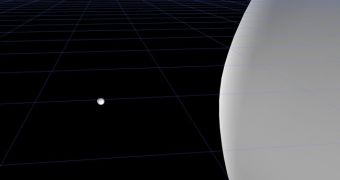In a new theoretical study, investigators were able to develop a computer model complex enough to allow them to accurately simulate what's going on during black hole collisions. In this particular research, a supermassive black hole was pitted against a much smaller black hole.
This was basically a reenactment of the ancient Biblical tale of David and Goliath, with the sole difference that, in the Universe, the Goliath always wins, investigators say.
In the model, one of the cosmic structures was about 100 times as massive as the other. This study was only made possible by recent advancements in computer programming and a lot of simulation time.
Astrophysicists are convinced that this type of event often takes place in the Universe. It may have also happened in our own galaxy several times, as the Milky Way cannibalized on dwarf galaxies in its path.
These cosmic formations may have had small black holes at their cores, but which were hundreds of times less massive than the supermassive behemoth in the central region of our own corner of the Universe.
“Nature doesn't collide black holes of equal masses. They have mass ratios of 1:3, 1:10, 1:100 or even 1:1 million,” explains in a statement expert Carlos Lousto.
“This puts us in a better situation for simulating realistic astrophysical scenarios and for predicting what observers should see and for telling them what to look for,” the expert adds.
He holds joint appointments, as an associate professor of mathematical sciences at the Rochester Institute of Technology (RIT), and as a member of the Center for Computational Relativity and Gravitation at the Institute.
In the supercomputer simulations, the massive black hole is set on a path that takes it directly through the smaller one. As this happens, the latter is in the end consumed, and incorporated into the larger one.
Modeling Albert Einstein's theory of general relativity is a very complex task for even advanced computers, and for a long time this meant that simulations of mass ratios of 1:100 were impossible to conduct, Space reports.
But Lousto and RIT expert Yosef Zlochower managed to conduct a simulation either way, by boosting the efficiency and performance of a supercomputer system featuring 70,000 processors.
The experts had to wait for three months before the results of their simulation were produced. The Ranger supercomputer is located at the University of Texas in Austin.
The team's work “is pushing the limit of what we can do today. Now we have the tools to deal with a new system,” says the director of the Center for Computational Relativity and Gravitation, Manuela Campanelli.
An upcoming issue of the top journal Physical Review Letters will present the full details of the new black hole collision simulations.

 14 DAY TRIAL //
14 DAY TRIAL //